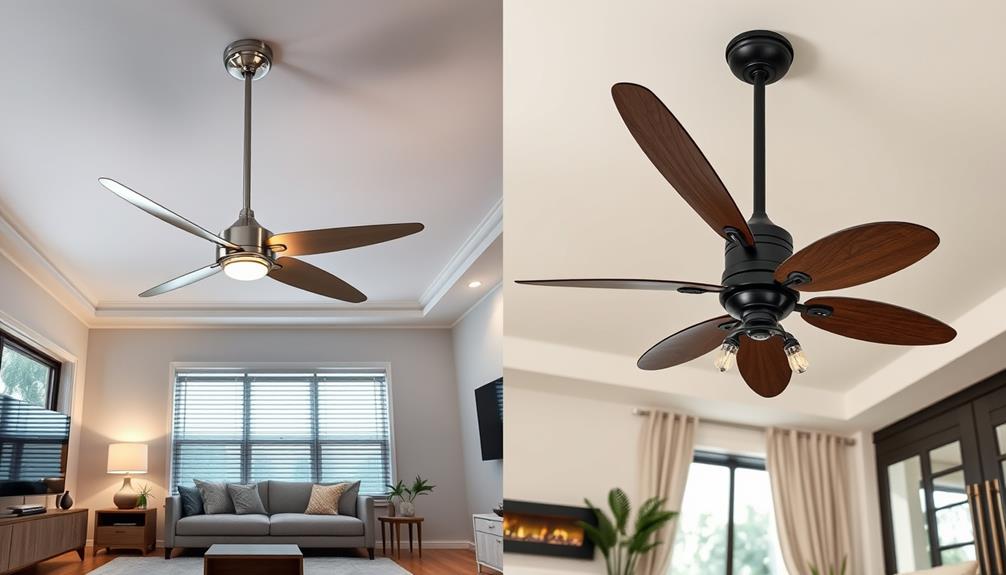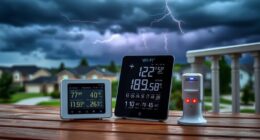When you're choosing between AC and DC ceiling fans, DC fans undeniably reign supreme. They're up to 70% more energy-efficient, saving you money on electricity bills while reducing your carbon footprint. Plus, DC fans operate more quietly and offer superior speed control for customized airflow. Although they come with a higher upfront cost, the long-term savings and lower maintenance make them worth it. AC fans may be cheaper initially, but their higher energy consumption can add up over time. Stick around to discover more factors that can influence your decision.
Key Takeaways
- DC fans are more energy-efficient, leading to lower electricity bills and reduced greenhouse gas emissions compared to AC fans.
- AC fans often generate more noise due to their induction motor design, while DC fans operate quietly with brushless motor technology.
- Although AC fans have a lower initial cost, DC fans offer long-term savings through reduced energy consumption.
- DC fans provide better speed control features, allowing for customized airflow and enhanced comfort in various settings.
- AC fans typically last longer but may have higher maintenance costs due to their motor design compared to lower-maintenance DC fans.
Power Source Comparison
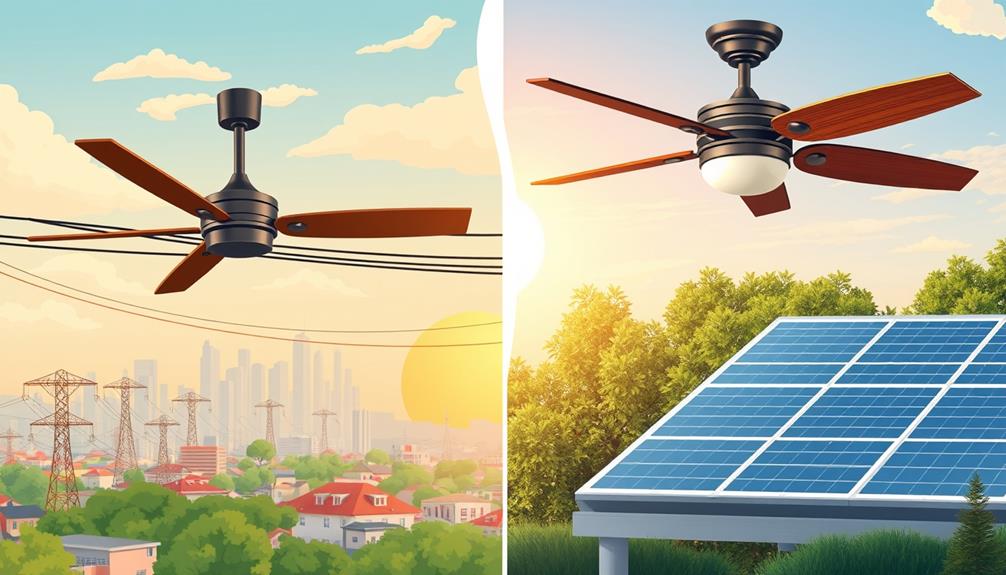
When choosing between AC and DC ceiling fans, it's important to understand how their power sources affect performance.
AC fans operate on alternating current and use induction motors, relying on electromagnetic induction. They typically run at 120 volts.
In contrast, DC fans utilize direct current, often sourced from batteries or solar panels, and feature brushless DC motors that enhance efficiency. This means DC fans usually consume less power while delivering comparable output.
The efficiency of the motor directly impacts how well the fan performs, with DC motors generally offering superior efficiency over their AC counterparts.
Consequently, if you're looking for better performance and lower energy consumption, considering the power source can notably influence your decision.
Energy Efficiency Insights
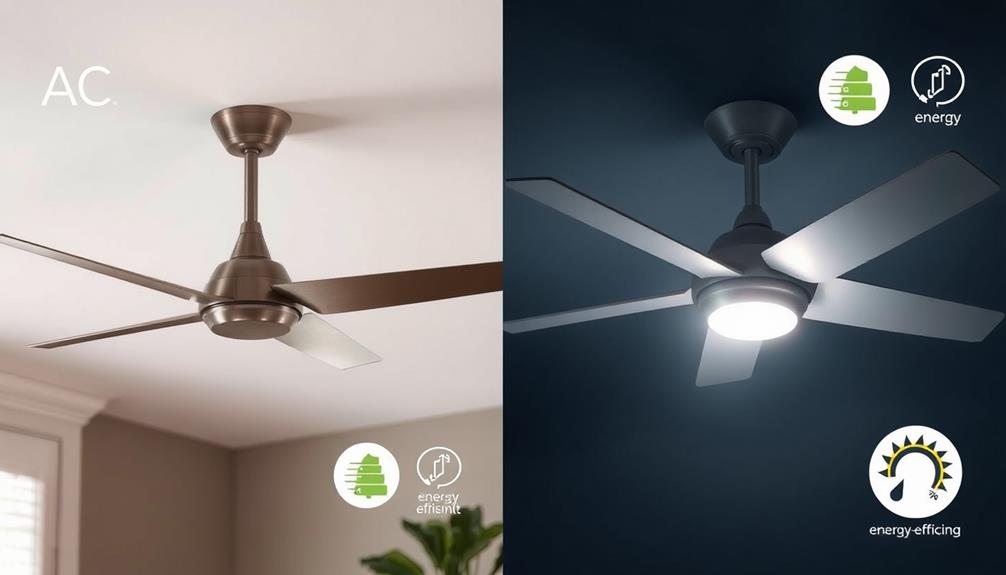
Understanding energy efficiency is essential when selecting ceiling fans, as it directly impacts both your utility bills and the environment.
When comparing AC and DC ceiling fans, you'll find that DC fans are markedly more energy-efficient. They utilize brushless DC motors, which consume less power while delivering the same cooling capacity. This means you can enjoy lower electricity bills and contribute to reduced greenhouse gas emissions.
Additionally, considering the importance of making environmentally conscious choices, you might also explore cold medications overview for health-related efficiency.
Although DC fans may have a higher initial cost, their long-term savings make them a cost-effective choice. Additionally, with less energy consumed, you're making a sustainable choice for the environment.
Ultimately, by opting for a DC fan, you're investing in both efficiency and eco-friendliness, making a positive impact in your home.
Noise Level Differences

Noise levels can make or break your comfort when using ceiling fans, and this is where the differences between AC and DC fans become clear.
AC fans are typically noisier due to their induction motor design, which can disrupt your peace. This can be particularly concerning for those who value a quiet home environment or need to focus on tasks, making it important to evaluate the common financial terms and jargon related to home upgrades.
On the other hand, DC fans utilize brushless motor technology, making them inherently quieter. Their optimized blade design and sound-absorbing materials further minimize noise, creating a soothing environment.
- AC fans may require maintenance for quieter operation.
- DC fans provide a serene atmosphere, perfect for bedrooms or offices.
- Advanced noise reduction techniques in DC fans enhance your listening experience.
Ultimately, if noise is a significant factor for you, opting for a DC fan could be the ideal choice.
Speed Control Features
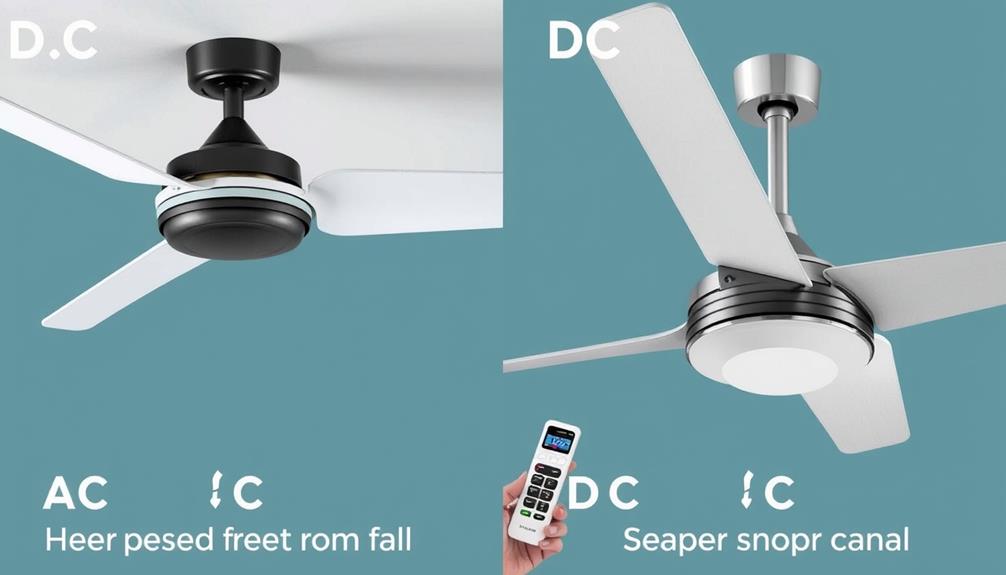
Speed control features play an essential role in optimizing your ceiling fan experience, allowing you to tailor airflow to your specific needs.
Both AC and DC fans offer various speed control options, including remote controls that let you adjust settings from across the room. Some remotes even come with preset speeds for quick selection and timer settings for automatic shut-off after a designated period.
Proper use can create a more pleasant living environment as well as enhance your comfort levels.
DC fans excel in providing precise speed control, enabling you to customize airflow effectively and enhance energy savings. Additionally, the reverse mode feature helps with air circulation in different seasons, making these fans versatile for year-round comfort.
With the right speed control features, you can easily create the perfect environment in your home.
Cost Analysis Overview
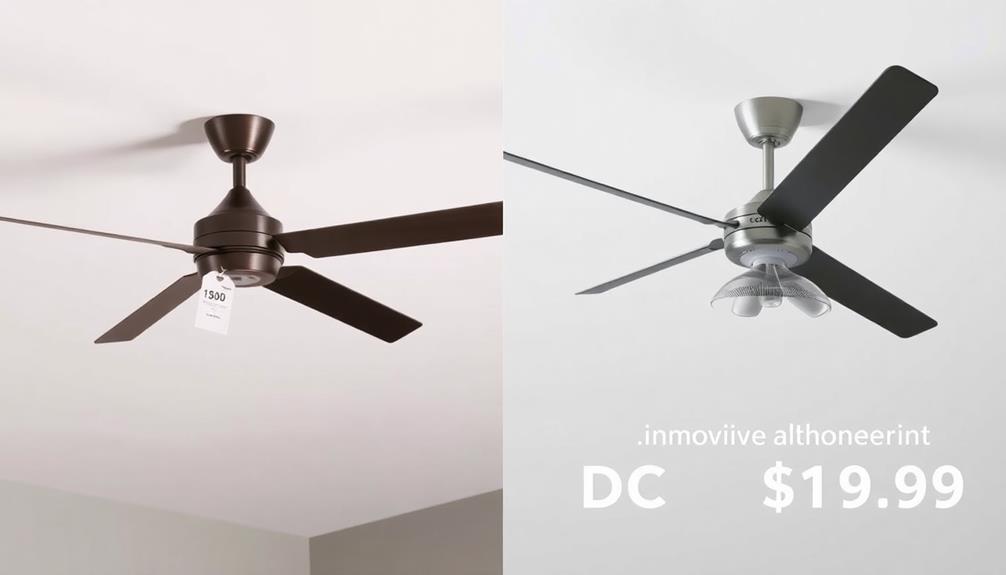
When evaluating the cost of ceiling fans, you'll find that both AC and DC options come with distinct financial implications.
While AC fans typically have a lower upfront cost, they may lead to higher energy bills over time due to increased power consumption. In contrast, modern Energy Star certified fans, such as stylish designs, can enhance airflow and reduce reliance on air conditioning, further contributing to your savings.
On the other hand, DC fans initially cost more but offer significant long-term savings on your electricity bill.
Here are some key points to evaluate:
- Initial Investment: DC fans are pricier at purchase.
- Energy Efficiency: DC fans consume less power, translating to savings.
- Longevity and Maintenance: AC fans last longer but require more upkeep.
Understanding these factors will help you make the best choice for your budget and needs.
Longevity and Maintenance
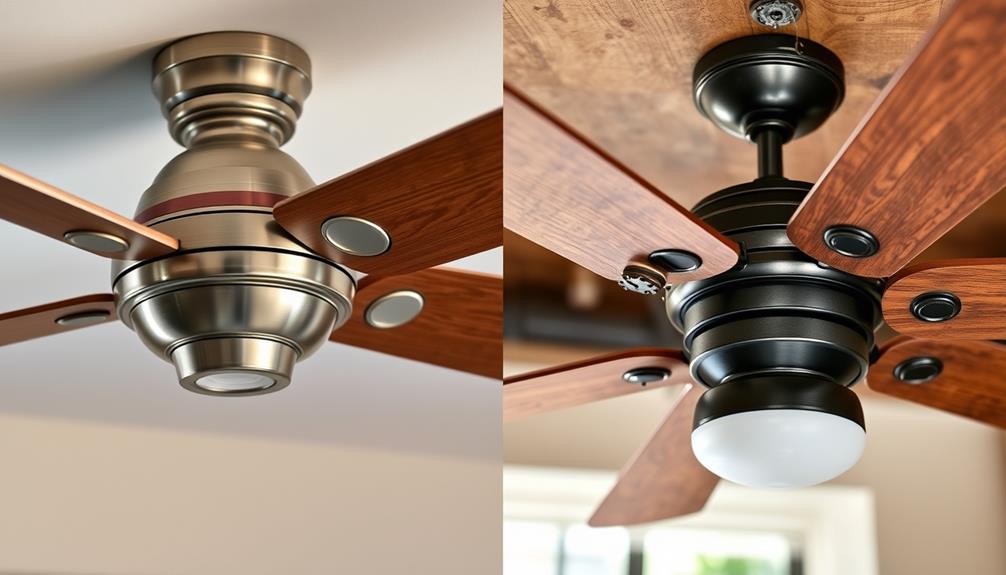
Understanding the longevity and maintenance of ceiling fans can greatly impact your overall satisfaction and cost-effectiveness.
AC ceiling fans typically last between 10 to 15 years with proper upkeep, while DC fans have a shorter lifespan of around 5 to 10 years.
However, DC fans require less maintenance because their brushless motors don't need bearing lubrication.
Regularly cleaning your fan blades and guaranteeing the motor functions smoothly can extend their lifespan.
Following the manufacturer's maintenance guidelines is essential for peak performance.
While AC fans might be cheaper initially, remember that their higher energy consumption can lead to increased costs over time.
Investing in a well-maintained fan, regardless of type, guarantees you enjoy its benefits for years.
Design and Aesthetics

In choosing a ceiling fan, design and aesthetics play an essential role in complementing your home decor. You want a fan that not only cools your space but also enhances its visual appeal.
AC and DC fans come in various styles and finishes, allowing you to find the perfect match for your interior design.
- Style Variety: Choose from traditional, contemporary, or rustic designs.
- Finishes: Options like brushed nickel, bronze, or wood can elevate your decor.
- Blade Shapes: Unique blade designs can add character and charm to any room.
Ultimately, the right ceiling fan can make a statement while providing comfort, so consider how each option aligns with your personal style and home environment.
Frequently Asked Questions
Can I Use a DC Fan With an AC Power Source?
No, you can't use a DC fan with an AC power source. Doing so can damage the fan, as DC fans require direct current for proper operation, which AC power can't provide. Always check compatibility first.
Do DC Fans Require Special Installation Compared to AC Fans?
DC fans don't require special installation compared to AC fans. You can install them similarly, but make certain you have the correct power source and follow the manufacturer's guidelines for peak performance and safety.
What Safety Features Should I Look for in Ceiling Fans?
What's more important than safety when choosing ceiling fans? Look for features like sturdy blades, secure mounting, overheat protection, and safety switches. These guarantee reliability and peace of mind while enjoying your cool breeze.
Are There Any Health Benefits Associated With Using Ceiling Fans?
Using ceiling fans can improve air circulation, helping regulate temperature and reduce humidity. They create a cooling breeze, which can enhance comfort and potentially alleviate respiratory issues by keeping air fresh and reducing stuffiness.
How Do I Choose the Right Size Ceiling Fan for My Room?
To choose the right size ceiling fan for your room, measure the space's square footage. Generally, larger rooms need wider fans, while smaller spaces require compact designs. Make certain airflow aligns with your comfort needs for best cooling.
Conclusion
In the battle of AC versus DC ceiling fans, the truth is clear: while AC fans offer affordability and a classic feel, DC fans shine with their energy efficiency and quiet operation. Many believe that paying a bit more upfront for a DC fan pays off in the long run through lower energy bills and reduced noise. Ultimately, choosing the right fan depends on your priorities—whether it's cost, comfort, or style that reigns supreme in your home. When it comes to choosing the right fan, it’s also important to consider the ceiling fan blade materials. Some materials, like wood, are known for their classic appeal and ability to complement traditional decor, while others, such as metal or plastic, offer durability and easy maintenance.
Additionally, the size and number of blades can also affect the fan’s performance and aesthetic appeal. It’s important to evaluate all of these factors before making a final decision on which ceiling fan is best for your home.
